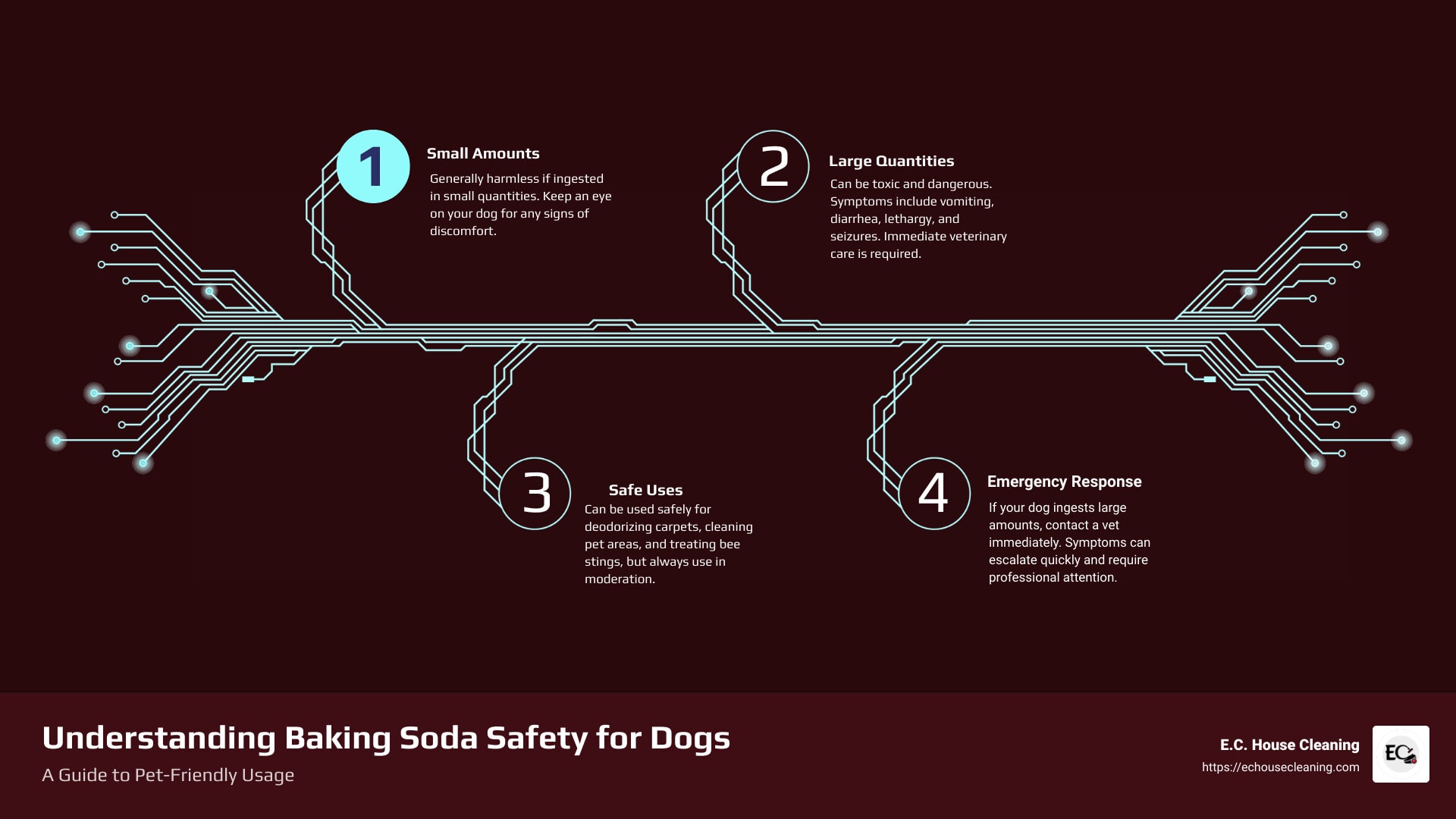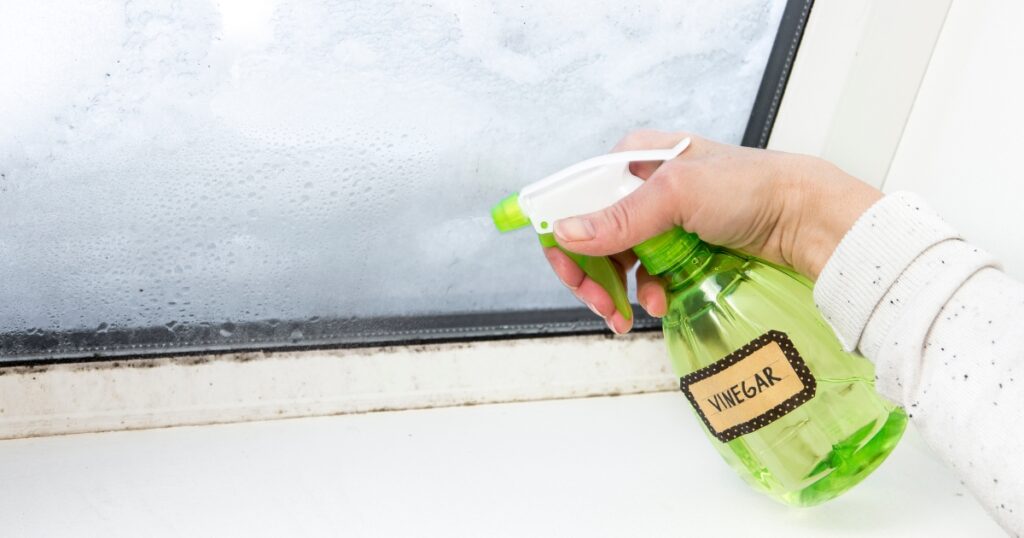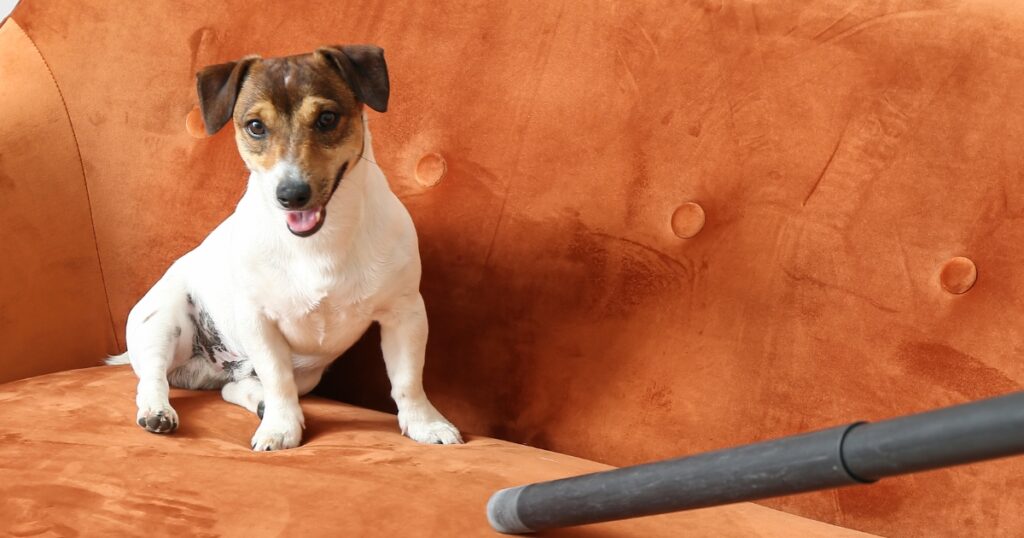Baking Soda Safety for Dogs: What You Need to Know
Baking soda, also known as sodium bicarbonate, is a common household item with many uses. It’s prized for its cleaning and deodorizing properties. However, when it comes to your furry friends, there are important safety considerations to keep in mind.
Many people believe baking soda is harmless to dogs, but this is a misconception. While it can be used safely in certain ways, such as in small amounts on carpets or diluted for cleaning, ingesting it in large quantities can be toxic for pets. To keep baking soda safe for your pets, use it in moderation and always consult your veterinarian if you have concerns.
Is baking soda harmful to dogs? The short answer is yes, but it depends on the amount consumed. Small accidental ingestions of baking soda generally do not harm your dog.
However, consuming large amounts can be toxic and dangerous. The toxic dose for dogs is around 10-20 grams per kilogram of body weight.
- Small amounts are usually harmless.
- Large quantities can lead to serious health issues.
- Symptoms of toxicity include vomiting, diarrhea, lethargy, and seizures.
Signs of overconsumption include vomiting, diarrhea, lethargy, and seizures. Additionally, electrolyte imbalance can occur as a consequence of baking soda toxicity.
My name is Eliana Coca, and I’ve spent over 20 years ensuring homes are clean and safe for families, including your four-legged members. Understanding the potential dangers of common household items, like baking soda, is essential for pet safety.
Read on to learn how to use baking soda around your pets safely.

Table of Contents
Understanding Baking Soda

Baking soda, also known as sodium bicarbonate, is a versatile household item often used for baking, cleaning, and deodorizing. Let’s break down its chemical composition, common household uses, and potential safety concerns for pets.
Baking soda can neutralize acidic substances like pet urine, effectively eliminating odors and improving cleanliness.
Chemical Composition of Sodium Bicarbonate
Baking soda’s chemical formula is NaHCO₃. It consists of:
- Sodium (Na)
- Hydrogen (H)
- Carbon (C)
- Oxygen (O)
When baking soda comes into contact with an acid, it reacts to produce carbon dioxide gas, which helps baked goods rise. This property makes it a popular choice in baking.
Household Uses
Baking soda is a staple in many homes due to its wide range of uses:
- Baking: Acts as a leavening agent.
- Cleaning: Its mild abrasiveness makes it ideal for scrubbing surfaces. It is also effective for cleaning pet bowls, ensuring they are free from stuck-on food and debris. It can also neutralize acidic substances like pet urine, effectively eliminating odors and improving cleanliness.
- Deodorizing: Absorbs odors from carpets, upholstery, and even pet bedding.
- Antacid: Can be used to neutralize stomach acid in humans.
Unlike baking soda, baking powder is essentially baking soda mixed with a dry acid, making it a different type of leavening agent used in baking.
Pet Safety Concerns
When it comes to pets, especially dogs, baking soda poses certain risks, including baking soda toxicity. While small accidental ingestions are usually harmless and may only cause minor stomach upset, larger quantities can be dangerous. Here’s why:
- Taste and Appeal: Baking soda has a salty, slightly bitter taste. Most dogs don’t find it appealing, but some might still try to eat it.
- Toxic Consumption Levels: The toxic dose for dogs is around 10-20 grams per kilogram of body weight. For example, a 10-pound dog would need to consume about 2-4 teaspoons (about 10-20 grams) to potentially experience toxicity.
- Symptoms of Toxicity: If a dog ingests too much baking soda, symptoms can appear within three hours and include: vomiting, diarrhea, lethargy, seizures, tremors, and shortness of breath.
If these symptoms appear, an emergency vet visit is crucial to ensure your dog’s safety.
Practical Uses Around Dogs
Despite the risks, baking soda can still be safely used around dogs if you follow certain guidelines:
- Deodorizing Carpets and Upholstery: Sprinkle a light coating of baking soda, let it sit for about an hour, then vacuum thoroughly.
- Cleaning Pet Areas: Use a mixture of baking soda and water to scrub pet bowls and other surfaces. Make sure to rinse well.
- Neutralize Acidic Substances: Baking soda can neutralize acidic substances like pet urine. Sprinkle baking soda on the affected area, let it sit for a while, then clean it up to eliminate odors and improve cleanliness.
- Bee Sting Treatment: Apply a paste of baking soda and water to the affected area to soothe the sting.
By understanding the chemical properties and safe usage guidelines of baking soda, you can keep your home clean while ensuring your dog’s safety.
Now that you know more about the basics of baking soda, let’s dive into the specific risks of baking soda to dogs and how to manage them effectively.
Risks of Baking Soda to Dogs

Ingestion Dangers
Dogs eat baking soda, while useful in many household applications, can pose a significant risk to dogs if ingested in large amounts. Although dogs generally do not find the salty, slightly bitter taste appealing, some curious pups might still consume it, leading to potential issues in their digestive system.
Here’s a critical point: small accidental ingestions are usually harmless, but larger quantities can be dangerous.
Symptoms of Baking Soda Toxicity
If a dog ingests too much baking soda, symptoms can manifest within three hours. These symptoms are a clear sign of toxicity and can escalate quickly. One of the severe effects of baking soda toxicity is an electrolyte imbalance, which can further complicate your dog’s health. Look out for:
- Vomiting: Often the first sign of trouble.
- Diarrhea: Indicates gastrointestinal distress.
- Lethargy: Your dog may appear unusually tired or weak.
- Seizures and Tremors: Severe neurological symptoms.
- Shortness of Breath: Difficulty in breathing can occur.
- Disorientation: Your dog may seem confused or uncoordinated.
Toxic Consumption Levels
Understanding the toxic consumption levels is crucial for pet owners. The toxic dose for dogs ranges from 10-20 grams per kilogram of body weight. Let’s break this down:
- A small dog (10 pounds) would need to consume about 2-4 teaspoons (10-20 grams) to potentially experience toxicity.
- A larger dog (50 pounds) would need to consume significantly more, approximately 4 small boxes of baking soda, to reach toxic levels.
Real-Life Example
Consider a story shared by a pet owner who learned this the hard way. Their small dog ingested a box of baking soda left unattended on the kitchen counter. Within hours, the dog showed signs of vomiting and lethargy. A quick call to the vet and immediate treatment were crucial in saving the dog’s life. This incident highlights the importance of prompt veterinary care in cases of baking soda ingestion.
Immediate Actions
If you suspect your dog has ingested a dangerous amount of baking soda, contact your veterinarian immediately. Quick action can prevent severe symptoms and save your dog’s life.
In the next section, we’ll explore safe uses of baking soda around dogs and how to avoid these risks while still benefiting from its many household applications.
Safe Uses of Baking Soda Around Dogs

While baking soda can be harmful if ingested in large amounts, it has several safe and beneficial uses around your home and pets when used correctly. Let’s look at how you can use baking soda safely.
Apply the baking soda paste to your dog’s fur, especially in areas with high insect activity, to serve as a natural flea repellent, helping to keep your pet free from pests.
Deodorizing Carpets
Pet odors can linger on carpets and upholstery. Baking soda is a natural deodorizer that can help freshen up these areas. Here’s how to use it safely:
- Sprinkle a Light Coating: Lightly sprinkle baking soda over the carpet or upholstery you want to deodorize.
- Let It Sit: Allow the baking soda to sit for about 30 minutes. This gives it time to absorb odors.
- Vacuum Thoroughly: Vacuum the area thoroughly to remove all the baking soda.
Tip: Always test a small, hidden area first to ensure the baking soda doesn’t discolor your carpet or fabric.
Cleaning Pet Areas
Baking soda is also effective for cleaning pet bowls, litter boxes, and other pet areas. Its mild abrasive properties help remove stuck-on food and debris without harsh chemicals. Follow these steps:
- Create a Paste: Mix baking soda with water to form a paste.
- Scrub Gently: Use the paste to scrub pet bowls, toys, or litter boxes.
- Rinse Well: Be sure to rinse thoroughly to remove any residue.
- Natural Flea Repellent: Apply the baking soda paste to your dog’s fur, especially in areas with high insect activity, to serve as a natural flea repellent.
Important: Ensure all items are completely dry before returning them to your pet.
Bee Sting Treatment
Bee stings can be painful for dogs, just as they are for humans. Baking soda can help alleviate some of the pain and swelling. Here’s what to do:
- Remove the Stinger: If possible, carefully remove the stinger with tweezers.
- Make a Paste: Mix baking soda and water to form a thick paste.
- Apply the Paste: Gently apply the paste to the affected area.
- Prevent Licking: Keep your dog from licking the area to allow the paste to work.
Note: Always monitor your dog for signs of an allergic reaction, such as swelling or difficulty breathing, and contact your vet immediately if these occur.
By using baking soda thoughtfully and following these guidelines, you can safely deodorize, clean, and even treat minor issues for your furry friend. Next, we’ll discuss what to do if your dog accidentally ingests baking soda, including immediate steps and when to seek veterinary care.
How to Respond if Your Dog Ingests Baking Soda

If your dog accidentally ingests baking soda, it’s crucial to act quickly to minimize potential harm. Here’s what you need to know about is baking soda harmful to dogs and the steps to take.
Immediate Steps
- Stay Calm: Panicking won’t help your dog. Stay calm to think clearly.
- Assess the Situation: Try to determine how much baking soda your dog has ingested. Even a rough estimate can help the vet.
- Contact Your Vet: Call your veterinarian immediately. If it’s after hours, contact the ASPCA Animal Poison Control Center at (888) 426-4435 or the Pet Poison Helpline® at (855) 764-7661.
- Follow Instructions: Your vet may instruct you to induce vomiting using hydrogen peroxide or bring your dog in for immediate treatment.
When to See a Vet
While small amounts might only cause minor stomach upset, larger amounts can be dangerous. Look out for these symptoms:
- Vomiting
- Diarrhea
- Lethargy
- Tremors
- Seizures
- Shortness of Breath
These symptoms can appear within 3 hours of ingestion. If your dog shows any of these signs, it’s crucial to see a vet immediately. You can also contact poison control centers like the ASPCA Animal Poison Control Center for immediate advice. Quick action can be life-saving.
Preventive Measures
Preventing your dog from ingesting baking soda is the best way to keep them safe. Here are some tips:
- Store Baking Soda Safely: Keep baking soda out of reach, just like any other household chemical.
- Monitor Your Dog: Be vigilant when using baking soda for cleaning or deodorizing around your home.
- Educate Family Members: Ensure everyone in the household knows the risks and keeps baking soda away from pets.
By following these steps, you can act quickly and effectively if your dog ingests baking soda. Prevention is always better than cure, so make sure to store baking soda safely and use it responsibly around your pets.
Next, we’ll address some frequently asked questions about baking soda and dogs, providing you with more detailed information to keep your furry friend safe.
Conclusion
When it comes to baking soda and dogs, moderation and safety are key. Here’s a quick summary of what we’ve learned:
- Baking soda can be harmful to dogs if ingested in large quantities. Symptoms of toxicity include vomiting, diarrhea, lethargy, and seizures. Immediate veterinary care is crucial if these symptoms appear.
- Safe uses of baking soda around dogs include deodorizing carpets, cleaning pet areas, and treating bee stings. Always use it sparingly and ensure thorough cleaning afterward to prevent ingestion.
- Avoid using baking soda as a flea treatment on your dog, as it is not effective and there are safer alternatives recommended by veterinarians.
Moderation is essential. While baking soda has many uses, it’s important to use it carefully to ensure the safety of your pets. Always keep baking soda out of reach and monitor your pets closely when using it in your home.
In case of an emergency, contact professionals immediately. If you suspect your dog has ingested a harmful amount of baking soda, reach out to your veterinarian or the ASPCA Animal Poison Control Center. Quick action can make all the difference.
Contact us today at E.C. House Cleaning, we prioritize the health and safety of your furry friends while providing top-notch cleaning services. For more information on pet-safe cleaning products, visit our eco-friendly cleaning products for pets page.
Frequently Asked Questions about Baking Soda and Dogs
What happens if a dog eats baking soda?
When a dog ingests baking soda, it can lead to several health issues, including soda toxicity. Symptoms usually appear within 3 hours and can include:
- Vomiting
- Diarrhea
- Lethargy
- Tremors
- Seizures
- Shortness of breath
These symptoms can be severe, so immediate actions are crucial. If your dog eats baking soda, follow these steps:
- Stay Calm: Keep a level head to handle the situation effectively.
- Estimate the Amount: Try to figure out how much baking soda your dog has consumed.
- Contact a Vet: Call your veterinarian or the ASPCA Animal Poison Control Center at (888) 426-4435.
- Follow Vet Instructions: Your vet may guide you to induce vomiting or bring your dog in for treatment.
Quick action can prevent severe outcomes and ensure your dog receives the care they need.
Is baking soda on carpet safe for dogs?
Using baking soda on carpets can be safe if done correctly. Here are some usage guidelines and safety tips:
- Sprinkle Lightly: Use a small amount of baking soda to deodorize carpets.
- Vacuum Thoroughly: Make sure to vacuum the area well after letting the baking soda sit for about 30 minutes.
- Avoid Access: Keep your dog out of the area while the baking soda is on the carpet and during vacuuming.
If you prefer alternative cleaning solutions, consider using products specifically designed for pet safety, like those from Better Life or Puracy.
Can I use baking soda on my dog as a natural flea repellent or for deodorizing?
Baking soda can be used on dogs for deodorizing, but there are some safety precautions to follow:
- Dry Bath: Sprinkle a light dusting of baking soda on your dog’s dry coat, avoiding the head. Rub it in and brush it out thoroughly.
- Wet Bath: Mix three tablespoons of baking soda with one teaspoon of mild dishwashing liquid and one teaspoon of baby oil. Spray this mixture on your dog, then towel dry.
- Dry Shampoo: Baking soda can also be used as a dry shampoo for dogs. Simply sprinkle it on your dog’s coat, rub it in, and brush it out. This is a great alternative for dogs that dislike water or when you’re short on time.
For fleas, baking soda is not the most effective treatment. Consult your vet for safer and more effective flea treatments.
By following these application methods, you can safely use baking soda around and on your dog. Always ensure you’re using the right amount and keeping your pet’s safety in mind.
Our Content
All content is written by E.C. House Cleaning’s professional cleaning company. We put our expertise in house cleaning services into each piece of content, focusing on providing valuable, accurate, and relevant information. With over 20 years of deep, full cleaning service industry experience in the Massachusetts and Boston area with a proven track record of pet-friendly house cleaning services in Massachusetts, commercial office cleaning Boston, and trust for customers as signaled by our hundreds of 5-star reviews, E.C. House Cleaning is an authority on residential and commercial cleaning services.
